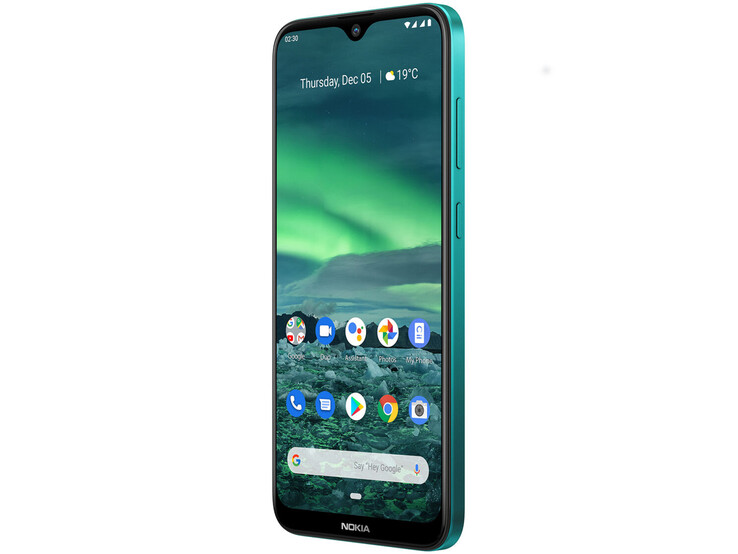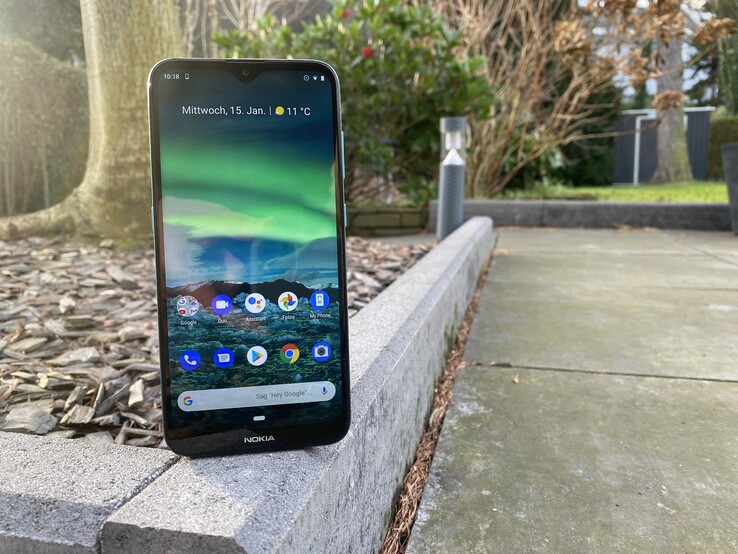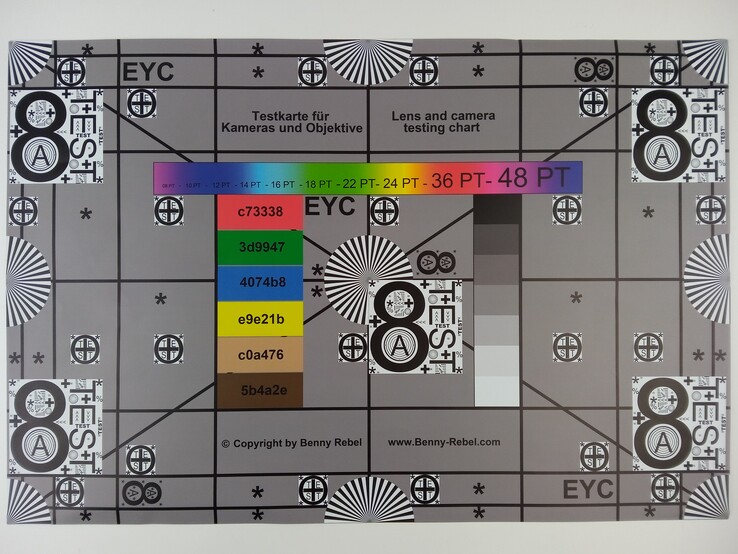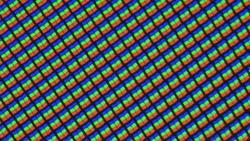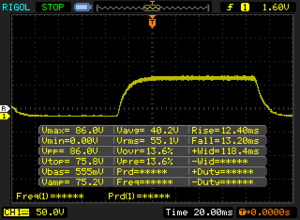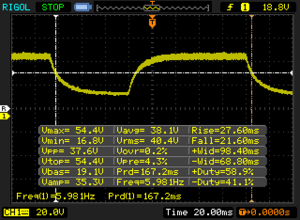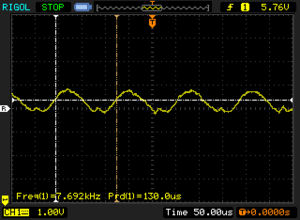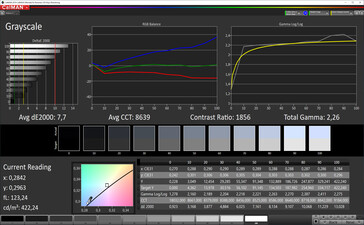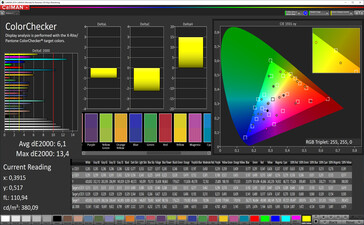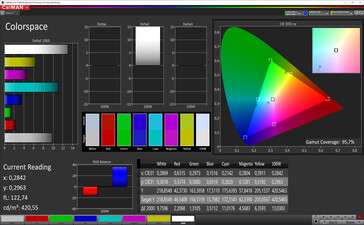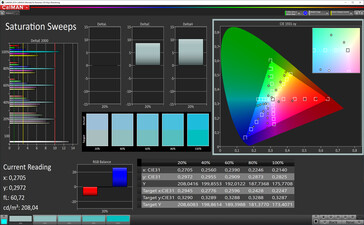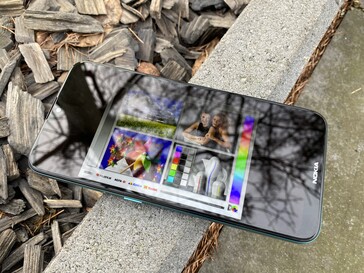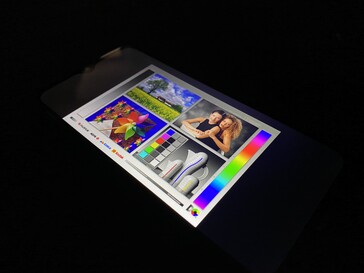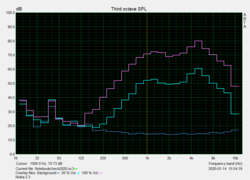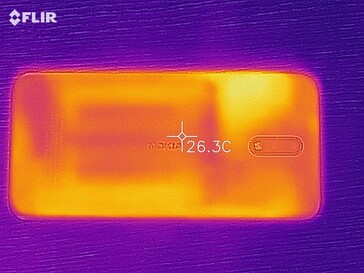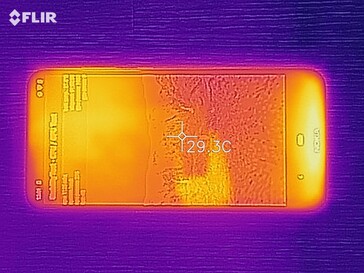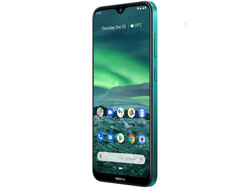Nokia 2.3 Review - Smartphone with long battery life and Android One for little money
Comparison devices
Bewertung | Rating Version | Datum | Modell | Gewicht | Laufwerk | Groesse | Aufloesung | Preis ab |
|---|---|---|---|---|---|---|---|---|
| 74.3 % v7 (old) | v7 (old) | 01 / 2020 | Nokia 2.3 Helio A22 MT6761, PowerVR GE8300 | 183 g | 32 GB eMMC Flash | 6.20" | 1520x720 | |
| 73.5 % v7 (old) | v7 (old) | 01 / 2020 | Wiko Y80 SC9863A, GE8322 / IMG8322 | 185 g | 16 GB eMMC Flash | 5.99" | 1440x720 | |
| 74.9 % v7 (old) | v7 (old) | 08 / 2019 | Samsung Galaxy A10 Exynos 7884B, Mali-G71 MP2 | 168 g | 32 GB eMMC Flash | 6.20" | 1520x720 | |
| 74.5 % v7 (old) | v7 (old) | 12 / 2019 | Xiaomi Redmi 8A SD 439, Adreno 505 | 188 g | 32 GB eMMC Flash | 6.22" | 1520x720 |
Case, equipment and operation
The body of the Nokia 2.3 consists of a roughened plastic surface and is available in black, turquoise and sand. The smartphone is very handy and solidly manufactured. The card slide is slightly recessed into the housing and stands out visibly from the frame. It can accommodate two nano-SIM cards as well as an additional microSD, but the latter does not support exFAT.
HMD Global still uses a Micro-USB connector, which supports OTG. The wired audio output is via the jack plug, an optional headset serves the FM receiver as an antenna. Unfortunately, the Nokia phone does not have DRM certification either, which is a pity considering the low panel resolution.
At the moment, Android 9.0 Pie still runs on the Nokia 2.3, but within the framework of Android One, Android 10 has already been confirmed without an exact date for the smartphone and Android 11 should also still be rolled out, if the hardware allows this.
The communication modules are limited to the minium. The single-band WLAN isn't particularly fast, but transfers data in combination with our reference router Netgear Nighthawk AX12 quite stable. The LTE bands are tuned to different regions and support all necessary frequency ranges. NFC must be avoided.
A special feature is the dedicated button for the Google Assistant on the left side. The touchscreen has good gliding characteristics and reacts quite fast. Unfortunately, there is no fingerprint scanner, but only a 2D face recognition, which does its job as reliably as possible, but is not very secure.
| Networking | |
| iperf3 transmit AX12 | |
| Nokia 2.3 | |
| Xiaomi Redmi 8A | |
| Wiko Y80 | |
| Samsung Galaxy A10 | |
| iperf3 receive AX12 | |
| Nokia 2.3 | |
| Xiaomi Redmi 8A | |
| Samsung Galaxy A10 | |
| Wiko Y80 | |
Cameras - Solid dual camera in Nokia 2.3
A total of three lenses are built into the Nokia 2.3. The front camera delivers decent pictures in daylight, but the portrait mode does tend to overdo it a bit. The second lens of the two main cameras on the back only collects depth information. Photos are illuminated homogeneously, but lack a bit of sharpness in detail and the dynamic range is rather small compared to the top models.
Videos are at best recorded at 1,080p (30 FPS) on both sides. The sound is accompanied by an occasional crackling sound.
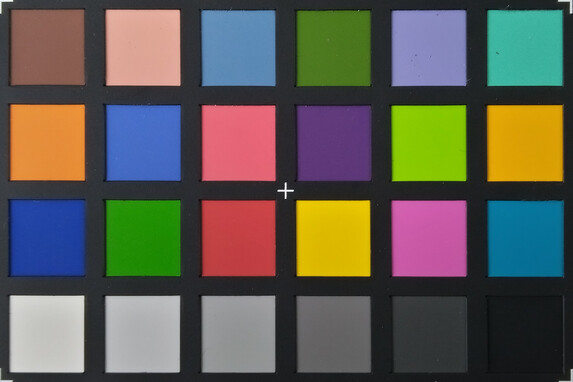
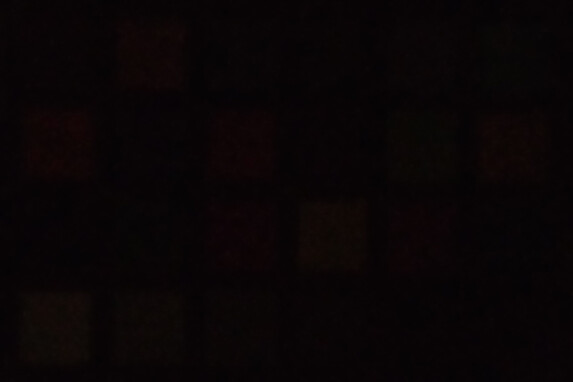
Display - Bright but flickering IPS in the Nokia phone
The Nokia 2.3's 6.2 inch IPS panel only works with the low HD resolution, so that minor blurring or pixelation can be quite visible in everyday life. The brightness is comparatively high with the ambient light sensor activated, but if you want to control the brightness manually, you'll only have a maximum of 417 cd/m² available. In the APL50 measurement, the luminosity remains at the same level, but the black level climbs to 0.34 cd/m², which lowers the contrast ratio to 1,488:1.
The measurement with the oscilloscope also showed a fairly constant high frequency flicker, but this is not pulse width modulation. The CalMAN analysis shows a strongly increased blue component, which gives the displayed content a cool note.
| |||||||||||||||||||||||||
Brightness Distribution: 92 %
Center on Battery: 515 cd/m²
Contrast: 2239:1 (Black: 0.23 cd/m²)
ΔE ColorChecker Calman: 6.1 | ∀{0.5-29.43 Ø4.78}
ΔE Greyscale Calman: 7.7 | ∀{0.09-98 Ø5}
95.7% sRGB (Calman 2D)
Gamma: 2.26
CCT: 8639 K
| Nokia 2.3 IPS, 1520x720, 6.2" | Wiko Y80 IPS, 1440x720, 6" | Samsung Galaxy A10 IPS, 1520x720, 6.2" | Xiaomi Redmi 8A IPS, 1520x720, 6.2" | |
|---|---|---|---|---|
| Response Times | -46% | 30% | -8% | |
| Response Time Grey 50% / Grey 80% * (ms) | 49.2 ? | 77.6 ? -58% | 38 ? 23% | 52 ? -6% |
| Response Time Black / White * (ms) | 25.6 ? | 34.4 ? -34% | 16 ? 37% | 28 ? -9% |
| PWM Frequency (Hz) | 7692 ? | 77 ? | 595 ? | |
| Screen | -5% | -1% | -6% | |
| Brightness middle (cd/m²) | 515 | 423 -18% | 451 -12% | 441 -14% |
| Brightness (cd/m²) | 488 | 417 -15% | 430 -12% | 421 -14% |
| Brightness Distribution (%) | 92 | 92 0% | 90 -2% | 89 -3% |
| Black Level * (cd/m²) | 0.23 | 0.27 -17% | 0.22 4% | 0.38 -65% |
| Contrast (:1) | 2239 | 1567 -30% | 2050 -8% | 1161 -48% |
| Colorchecker dE 2000 * | 6.1 | 5.7 7% | 5.44 11% | 4.46 27% |
| Colorchecker dE 2000 max. * | 13.4 | 9.8 27% | 11.94 11% | 8.01 40% |
| Greyscale dE 2000 * | 7.7 | 7.2 6% | 7.8 -1% | 5.4 30% |
| Gamma | 2.26 97% | 2.24 98% | 2.206 100% | 2.146 103% |
| CCT | 8639 75% | 8079 80% | 9149 71% | 7901 82% |
| Total Average (Program / Settings) | -26% /
-13% | 15% /
5% | -7% /
-6% |
* ... smaller is better
Display Response Times
| ↔ Response Time Black to White | ||
|---|---|---|
| 25.6 ms ... rise ↗ and fall ↘ combined | ↗ 12.4 ms rise | |
| ↘ 13.2 ms fall | ||
| The screen shows relatively slow response rates in our tests and may be too slow for gamers. In comparison, all tested devices range from 0.1 (minimum) to 240 (maximum) ms. » 60 % of all devices are better. This means that the measured response time is worse than the average of all tested devices (20.2 ms). | ||
| ↔ Response Time 50% Grey to 80% Grey | ||
| 49.2 ms ... rise ↗ and fall ↘ combined | ↗ 27.6 ms rise | |
| ↘ 21.6 ms fall | ||
| The screen shows slow response rates in our tests and will be unsatisfactory for gamers. In comparison, all tested devices range from 0.165 (minimum) to 636 (maximum) ms. » 85 % of all devices are better. This means that the measured response time is worse than the average of all tested devices (31.6 ms). | ||
Screen Flickering / PWM (Pulse-Width Modulation)
| Screen flickering / PWM detected | 7692 Hz | ≤ 25 % brightness setting | |
The display backlight flickers at 7692 Hz (worst case, e.g., utilizing PWM) Flickering detected at a brightness setting of 25 % and below. There should be no flickering or PWM above this brightness setting. The frequency of 7692 Hz is quite high, so most users sensitive to PWM should not notice any flickering. In comparison: 53 % of all tested devices do not use PWM to dim the display. If PWM was detected, an average of 8111 (minimum: 5 - maximum: 343500) Hz was measured. | |||
Performance, emissions and battery life
The weak MediaTek-SoC is supported by 2 GB RAM and ranks at the end of the comparison field in terms of performance. The system performance is still surprisingly smooth, but the loading times sometimes drag on simple games and more demanding titles are hard to think of. A very weak configuration, especially in view of the upcoming newer Android versions. The Nokia 2.3 doesn't have any noteworthy surface heating, which could be described as such.
The loudspeaker on the bottom edge sounds a bit thin and tinny in everyday use, but it is sufficient up to a medium volume. The output via the sound is much better there, but it doesn't offer a precise reproduction either. We still liked the sound via Bluetooth (SBC or LDAC) best.
The Nokia 2.3 achieves really good runtimes with its 4,000 mAh battery, which will easily last for a day of intensive use. If you use your smartphone only moderately, you'll even have more than two days in it.
| PCMark for Android - Work 2.0 performance score (sort by value) | |
| Nokia 2.3 | |
| Wiko Y80 | |
| Samsung Galaxy A10 | |
| Xiaomi Redmi 8A | |
| Average Mediatek Helio A22 MT6761 (4195 - 5511, n=11) | |
| GFXBench | |
| on screen Aztec Ruins Normal Tier Onscreen (sort by value) | |
| Nokia 2.3 | |
| Wiko Y80 | |
| Samsung Galaxy A10 | |
| Xiaomi Redmi 8A | |
| Average Mediatek Helio A22 MT6761 (2.3 - 6.1, n=14) | |
| Average of class Smartphone (6.2 - 166, n=211, last 2 years) | |
| 1920x1080 Aztec Ruins Normal Tier Offscreen (sort by value) | |
| Nokia 2.3 | |
| Wiko Y80 | |
| Samsung Galaxy A10 | |
| Xiaomi Redmi 8A | |
| Average Mediatek Helio A22 MT6761 (1.9 - 4.2, n=14) | |
| Average of class Smartphone (3.4 - 367, n=211, last 2 years) | |
| Nokia 2.3 | Wiko Y80 | Samsung Galaxy A10 | Xiaomi Redmi 8A | Average 32 GB eMMC Flash | Average of class Smartphone | |
|---|---|---|---|---|---|---|
| AndroBench 3-5 | -47% | -12% | -11% | -23% | 802% | |
| Sequential Read 256KB (MB/s) | 261.8 | 91.3 -65% | 296.4 13% | 282 8% | 242 ? -8% | 2222 ? 749% |
| Sequential Write 256KB (MB/s) | 149.2 | 65.1 -56% | 101.7 -32% | 106.4 -29% | 100.5 ? -33% | 1841 ? 1134% |
| Random Read 4KB (MB/s) | 69.6 | 19.06 -73% | 73.4 5% | 73.1 5% | 43.1 ? -38% | 294 ? 322% |
| Random Write 4KB (MB/s) | 30.33 | 6.09 -80% | 13.3 -56% | 15.8 -48% | 22.3 ? -26% | 334 ? 1001% |
| Sequential Read 256KB SDCard (MB/s) | 83.7 ? | 80.6 ? -4% | 78.8 ? -6% | 84.9 ? 1% | 71.8 ? -14% | |
| Sequential Write 256KB SDCard (MB/s) | 63.7 ? | 61.6 ? -3% | 65.3 ? 3% | 61.7 ? -3% | 52.9 ? -17% |
Temperature
(+) The maximum temperature on the upper side is 28.9 °C / 84 F, compared to the average of 35.2 °C / 95 F, ranging from 21.9 to 247 °C for the class Smartphone.
(+) The bottom heats up to a maximum of 28.4 °C / 83 F, compared to the average of 34 °C / 93 F
(+) In idle usage, the average temperature for the upper side is 26.5 °C / 80 F, compared to the device average of 32.9 °C / 91 F.
Speakers
Nokia 2.3 audio analysis
(+) | speakers can play relatively loud (85 dB)
Bass 100 - 315 Hz
(-) | nearly no bass - on average 34.3% lower than median
(±) | linearity of bass is average (9.3% delta to prev. frequency)
Mids 400 - 2000 Hz
(±) | reduced mids - on average 5.8% lower than median
(±) | linearity of mids is average (7.3% delta to prev. frequency)
Highs 2 - 16 kHz
(±) | higher highs - on average 6.7% higher than median
(±) | linearity of highs is average (7.1% delta to prev. frequency)
Overall 100 - 16.000 Hz
(±) | linearity of overall sound is average (27.4% difference to median)
Compared to same class
» 71% of all tested devices in this class were better, 5% similar, 24% worse
» The best had a delta of 11%, average was 35%, worst was 134%
Compared to all devices tested
» 83% of all tested devices were better, 4% similar, 13% worse
» The best had a delta of 4%, average was 24%, worst was 134%
Wiko Y80 audio analysis
(+) | speakers can play relatively loud (83.6 dB)
Bass 100 - 315 Hz
(-) | nearly no bass - on average 41.2% lower than median
(+) | bass is linear (5.5% delta to prev. frequency)
Mids 400 - 2000 Hz
(±) | reduced mids - on average 8.5% lower than median
(±) | linearity of mids is average (10.1% delta to prev. frequency)
Highs 2 - 16 kHz
(+) | balanced highs - only 4.5% away from median
(+) | highs are linear (2.5% delta to prev. frequency)
Overall 100 - 16.000 Hz
(±) | linearity of overall sound is average (29.9% difference to median)
Compared to same class
» 78% of all tested devices in this class were better, 3% similar, 19% worse
» The best had a delta of 11%, average was 35%, worst was 134%
Compared to all devices tested
» 88% of all tested devices were better, 3% similar, 10% worse
» The best had a delta of 4%, average was 24%, worst was 134%
Battery life
| Nokia 2.3 4000 mAh | Wiko Y80 4000 mAh | Samsung Galaxy A10 3400 mAh | Xiaomi Redmi 8A 5000 mAh | Average of class Smartphone | |
|---|---|---|---|---|---|
| Battery Runtime | |||||
| WiFi Websurfing (h) | 15.3 | 11.6 -24% | 12.6 -18% | 19.1 25% | 19.3 ? 26% |
Pros
Cons
Verdict - Cheap Finn
With the Nokia 2.3, HMD Global has created a successful entry-level smartphone, which stands out from the crowd with Android One and promises long updates. Those who buy the smartphone directly in the online shop of Nokia also receive a further year of warranty.
The display delivers good test results and presents itself comparatively bright. It doesn't use PWM, but a high-frequency flickering is noticed in the test, which could possibly be a problem for sensitive people.
If you are looking for a cheap smartphone with Android One, you will hardly be able to get past the Nokia 2.3.
Furthermore, the Nokia 2.3 offers an audio jack, an FM receiver, 2D face recognition, a dedicated button for the Google Assistant, as well as very good battery life. A fingerprint sensor, a notification LED and DRM certification have to be omitted.
The cameras do a decent job in good lighting conditions, but they are far away from the possibilities that smartphone photography offers today. Moreover, the speaker is not really convincing, and the SoC is only at the lower end of the performance scale.
Nevertheless, HMD Global offers a coherent overall package that should be of particular interest to users who plan to use their smartphone for several years.
Nokia 2.3
- 01/27/2020 v7 (old)
Daniel Schmidt




